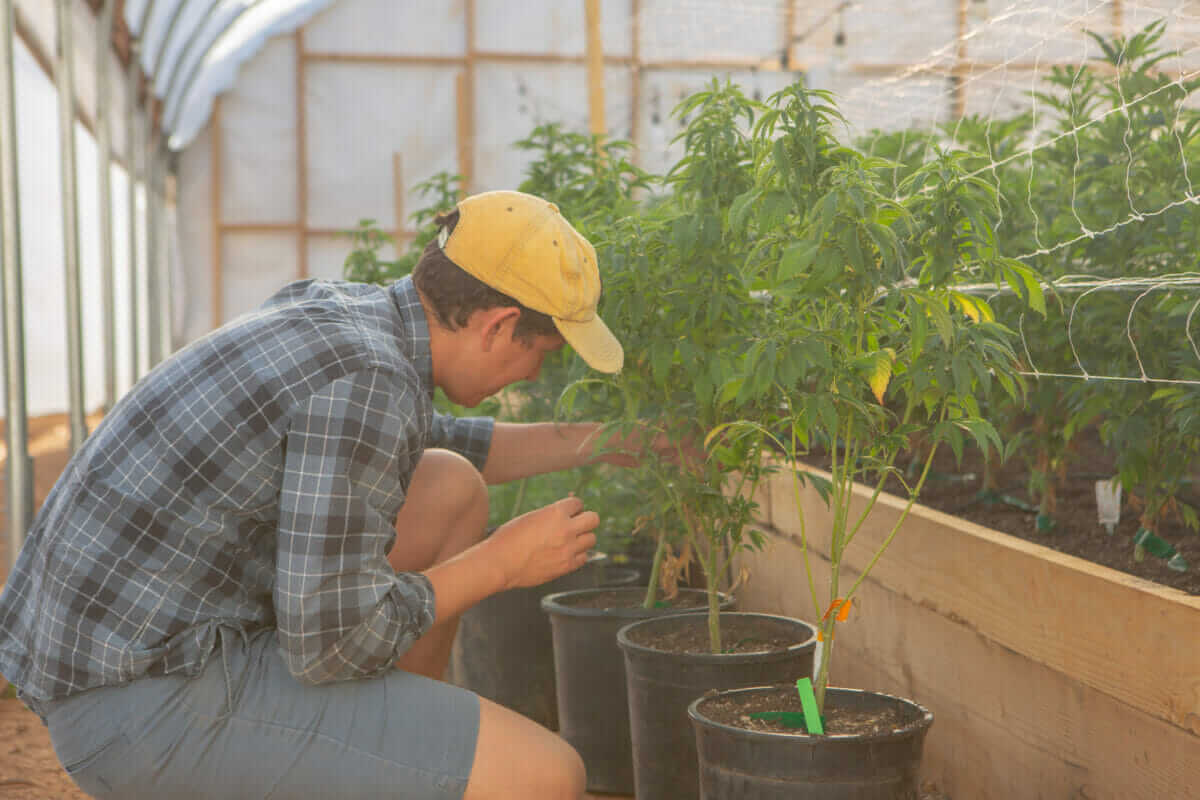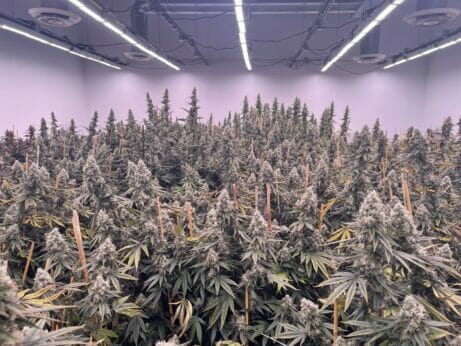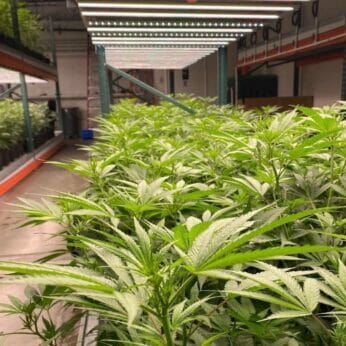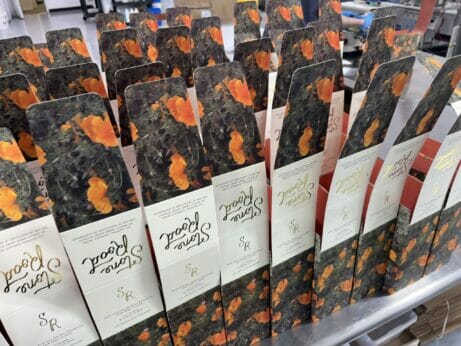Growing Green: Cannabis Farmers Tackle Sustainability
With a burgeoning demand for marijuana, both legal and illegal operations face scrutiny over water issues, energy usage, and plastic pollution.
Growing Green: Cannabis Farmers Tackle Sustainability
With a burgeoning demand for marijuana, both legal and illegal operations face scrutiny over water issues, energy usage, and plastic pollution.

Lex Corwin inspects the plants inside the greenhouse at Stone Road Farmscourtesy Stone Road Farms.
In 2016, when Lex Corwin opened his off-grid, biodynamic cannabis farm in Nevada City, California, he incorporated sustainability into every facet of the company. He powered the greenhouse with on-site solar panels, opted for natural pest control instead of synthetics and sold his products in recyclable, 99 percent plastic-free packaging. “It’s a very important political topic for a lot of people in our generation,” says the 30-year-old founder and CEO of Stone Road.
Not only do Millennials and Gen Z-ers widely support marijuana legalization, but they also engage more with issues surrounding the climate crisis. With sales of legal cannabis expected to more than double by 2030, producers of the nation’s sixth-most valuable crop have a problem: Cannabis has a substantial environmental footprint.
Read More
The American Agriculture Industry is Making (a Little) Room for Luxury Fruit
A few American companies are cashing in on the exclusive produce trend.
Research on the sustainability of cannabis cultivation, although nascent because of its illegal federal status, indicates an array of environmental impacts. Growing cannabis requires massive water and energy resources while contributing to air, land and water pollution and soil damage. Corwin is part of a small but growing group of farmers working to transform the least green parts of the industry into more sustainable and profitable practices.

Turning grass blue
Cannabis is a water-intensive crop. Grown indoors or in the wild, each plant requires between five and six gallons of water per day—nearly twice that of other commodity crops. In California, irrigated agriculture already accounts for 70 percent to 80 percent of all water consumption.
Inside Stone Road’s half-acre of greenhouses, says Corwin, the plants require much less than five gallons of water per week because they’re small, thanks to their two- to three-month lifecycle. The outdoor plants grown on his 57-acre outdoor farm, however, grow for four to six months and require much more water “because they’re massive.”
Take Action
So, You Want to Be a Marijuana Farmer?
Unlike most cannabis operations, Stone Road doesn’t use municipal or stream water, instead irrigating its indoor and outdoor plants from two wells that draw from an underground aquifer. This geologically unique system preserves nearby aquatic ecosystems and ensures that Stone Road has ample supplies, even during droughts.
Stone Road’s sustainable infrastructure stands in stark contrast to the water stolen by unlicensed cannabis operations across the Golden State. In San Bernadino County alone, a reported 4,000 acre-feet of water was stolen in 2021—enough to submerge 4,000 football stadiums in a foot of water.
Water woes aren’t just an issue for California farmers; Colorado cannabis growers face an even drier future. Home to the worst conditions in the West, more than half of the state is in some level of drought, with 86 percent of the water supply already dedicated to agriculture.
Those numbers don’t concern Andrew Mahon, head of cultivation at Veritas in Denver. “We built our own irrigation system to fit the style of growing we do,” he says. Seasoned cultivation staff, not a digital sensor, determine the precise amount of moisture the plants need.
Consequently, the 20,000 square feet of grow space at Veritas uses significantly less water than the average indoor cannabis farm—half to one gallon a day during flowering and just 100 to 200 millilitres a day during the vegetation stage, says Mahon.
Water-conscious techniques like these don’t just prevent overwatering. They can also stem the flow of runoff, which can tax local water treatment systems. That’s because many cannabis operations apply insecticides, acaricides, fungicides and plant growth regulators that can disrupt habitats of fish, amphibians and rare carnivores.
While Mahon could use EPA-registered pesticides, he says he primarily chooses minimum-risk pesticides “typically composed of essential oils like rosemary oil [and] thyme oil.” Corwin eschews chemicals altogether, instead opting for “an army of predator mites, ladybugs and beneficial fungi” to deter other pests, stave off mold and keep the farm’s water supply clean.

Cooling down energy use
Indoor grow houses allow farmers to govern the lifecycle of cannabis using artificial lighting and climate control, which enables rapid turnaround for sometimes dozens of harvests each year. But with that speed comes massive greenhouse gas emissions from lighting, heating, cooling and dehumidification—powered mostly by petrochemicals.
“The elephant in the room,” says Mahon, “is LED lighting.” For years, the industry has relied on high-intensity discharge lamps such as metal halides and high-pressure sodium lights (HSPs), fixtures considered efficient by 1960s and 1970s standards. Compared to HSPs, light-emitting diodes provide more light, require very little energy to run and emit far less heat, substantially reducing the demand for cooling and the energy in general required to produce cannabis.
Dion Foley, chief of operations at Koala Green Development in Adelanto, California, prefers the new tech. “LEDs are insanely more energy efficient,” he says. Koala Green Development has been growing with LEDs since 2018, and its 15,000 square feet of grow space costs $20,000 per month to power. Similarly sized facilities not growing with LEDs, says Foley, spend between $50,000 and $60,000.
For some growers, the cutting edge of sustainability in cannabis has moved toward energy generation. At Stone Road, on-site solar panels provide enough power to run the supplemental LED lighting in the greenhouses. Because the sides can be opened manually to cool the plants and prevent mold, there’s no need for HVAC or dehumidifying, says Corwin.
Growing under LEDs also allows for much higher yields each harvest, “meaning that grows will not have to be as large in the future and, therefore, the footprint of the industry will decrease over time,” says Mahon.
While Veritas has not fully switched to LEDs, Mahon says the company has plans to upgrade in the near future. In the meantime, more than a quarter of Colorado’s energy currently comes from wind and solar, and 2022 was the first year that renewables generated more energy than coal and nuclear power. As the grid continues to decarbonize and LEDs become the industry standard, the emissions of indoor cannabis cultivation will continue to shrink.
.

Pot’s pernicious plastics
Zipper bags, rigid “doob tubes,” spent vape cartridges and other plastic pollution generated by marijuana packaging also contribute to the global plastic crisis, although it’s unclear how much of an impact cannabis packaging has on an already massive problem . A jaw-dropping 363 billion pounds of plastics choke the world’s oceans, eventually finding their way into the human food chain. Single-use plastics also take hundreds of years to decompose, releasing harmful methane and ethylene gasses as they do.
A daily surfer, Corwin says he can’t imagine swimming into a piece of plastic packaging that his company had created, which is why Stone Road’s current packaging is made from 100 percent post-consumer recycled materials and will soon be 100 percent plastic-free.

Yet plastic remains the most popular packaging material in the industry. Of the limited number of options that meet the child safety regulations, plastic is the most economically priced, says Foley. A glass jar, for example, can cost $1.50, whereas a Mylar bag can cost as little as $0.20.
When opting for plastic over glass, Foley says an established company could save between $10,000 and $75,000 a year, depending on the number of accounts. That might not seem like a lot of money in the context of a $37-billion industry; but, he says, “cannabis companies are operating on extremely tight margins in the current struggling cannabis market.
“You’d charge a dispensary somewhere between $2.50 and $5 more per eighth (3.5 grams) for jarred cannabis,” he continues, with the cost of sustainable packaging passed on to consumers. That poses a problem for producers in a market increasingly flooded with product, driving down prices for both legal and illegal cannabis. Corwin says this has led consumers to prioritize “value over everything.”
Foley swore up and down he’d never sell cannabis in plastic until the price of doing business pushed his hand. Many farmers simply “can’t justify doing something that’s good for the environment when it costs more,” he says.
Without financial incentives to encourage more eco-friendly practices, Foley fears many smaller-scale operations won’t have the working capital to make the sustainable switch. To survive the second decade of recreational legalization, cannabis farmers will have to be as resilient as the plants they cultivate.
Follow us

This work is licensed under a Creative Commons Attribution-NoDerivatives 4.0 International License.
Want to republish a Modern Farmer story?
We are happy for Modern Farmer stories to be shared, and encourage you to republish our articles for your audience. When doing so, we ask that you follow these guidelines:
Please credit us and our writers
For the author byline, please use “Author Name, Modern Farmer.” At the top of our stories, if on the web, please include this text and link: “This story was originally published by Modern Farmer.”
Please make sure to include a link back to either our home page or the article URL.
At the bottom of the story, please include the following text:
“Modern Farmer is a nonprofit initiative dedicated to raising awareness and catalyzing action at the intersection of food, agriculture, and society. Read more at <link>Modern Farmer</link>.”
Use our widget
We’d like to be able to track our stories, so we ask that if you republish our content, you do so using our widget (located on the left hand side of the article). The HTML code has a built-in tracker that tells us the data and domain where the story was published, as well as view counts.
Check the image requirements
It’s your responsibility to confirm you're licensed to republish images in our articles. Some images, such as those from commercial providers, don't allow their images to be republished without permission or payment. Copyright terms are generally listed in the image caption and attribution. You are welcome to omit our images or substitute with your own. Charts and interactive graphics follow the same rules.
Don’t change too much. Or, ask us first.
Articles must be republished in their entirety. It’s okay to change references to time (“today” to “yesterday”) or location (“Iowa City, IA” to “here”). But please keep everything else the same.
If you feel strongly that a more material edit needs to be made, get in touch with us at [email protected]. We’re happy to discuss it with the original author, but we must have prior approval for changes before publication.
Special cases
Extracts. You may run the first few lines or paragraphs of the article and then say: “Read the full article at Modern Farmer” with a link back to the original article.
Quotes. You may quote authors provided you include a link back to the article URL.
Translations. These require writer approval. To inquire about translation of a Modern Farmer article, contact us at [email protected]
Signed consent / copyright release forms. These are not required, provided you are following these guidelines.
Print. Articles can be republished in print under these same rules, with the exception that you do not need to include the links.
Tag us
When sharing the story on social media, please tag us using the following: - Twitter (@ModFarm) - Facebook (@ModernFarmerMedia) - Instagram (@modfarm)
Use our content respectfully
Modern Farmer is a nonprofit and as such we share our content for free and in good faith in order to reach new audiences. Respectfully,
No selling ads against our stories. It’s okay to put our stories on pages with ads.
Don’t republish our material wholesale, or automatically; you need to select stories to be republished individually.
You have no rights to sell, license, syndicate, or otherwise represent yourself as the authorized owner of our material to any third parties. This means that you cannot actively publish or submit our work for syndication to third party platforms or apps like Apple News or Google News. We understand that publishers cannot fully control when certain third parties automatically summarize or crawl content from publishers’ own sites.
Keep in touch
We want to hear from you if you love Modern Farmer content, have a collaboration idea, or anything else to share. As a nonprofit outlet, we work in service of our community and are always open to comments, feedback, and ideas. Contact us at [email protected].by Gia Mora, Modern Farmer
July 24, 2023
Modern Farmer Weekly
Solutions Hub
Innovations, ideas and inspiration. Actionable solutions for a resilient food system.
ExploreExplore other topics
Share With Us
We want to hear from Modern Farmer readers who have thoughtful commentary, actionable solutions, or helpful ideas to share.
SubmitNecessary cookies are absolutely essential for the website to function properly. This category only includes cookies that ensures basic functionalities and security features of the website. These cookies do not store any personal information.
Any cookies that may not be particularly necessary for the website to function and are used specifically to collect user personal data via analytics, ads, other embedded contents are termed as non-necessary cookies.